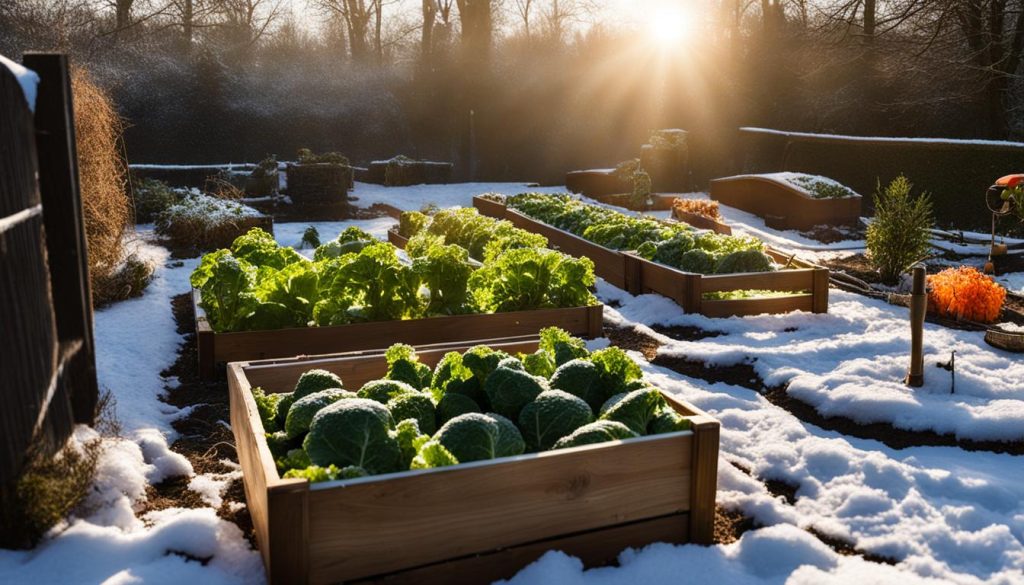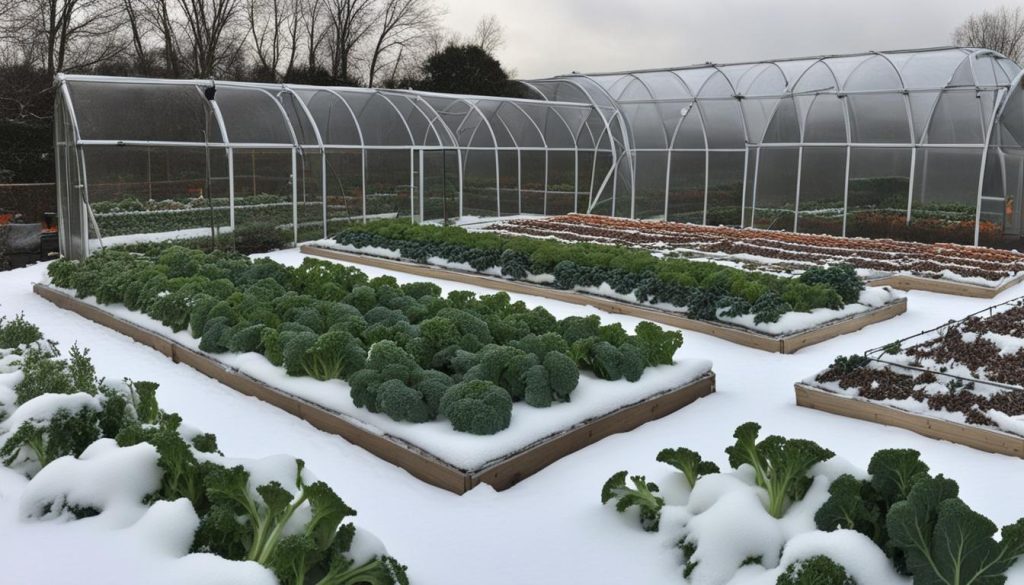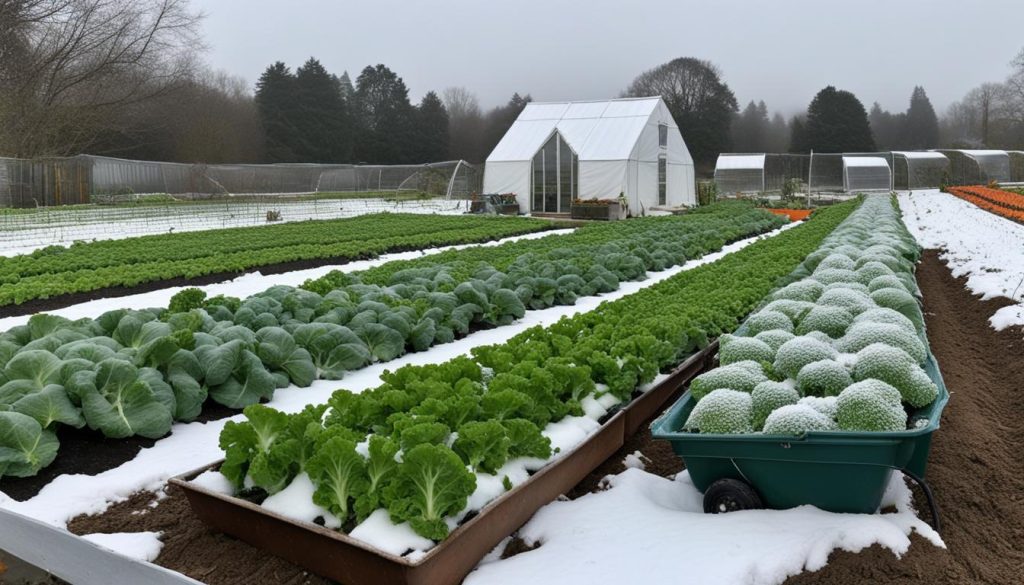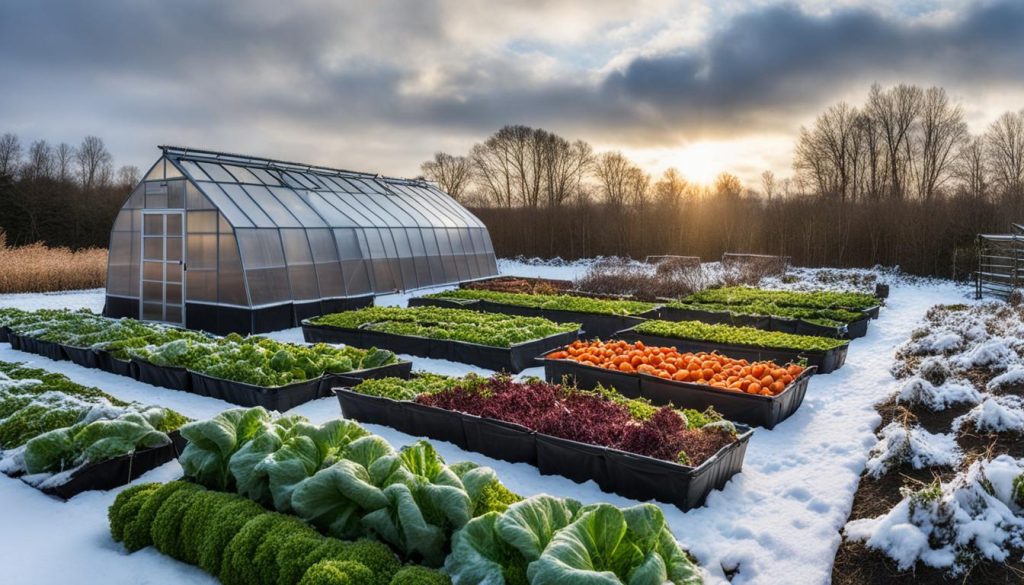
How to Successfully Grow Vegetables in Your Garden During Winter
Gardening during the winter months may seem challenging, but with the right knowledge and techniques, you can enjoy a bountiful harvest of fresh vegetables. In this winter gardening guide, I will share valuable tips and advice for successfully growing vegetables in your garden throughout the colder season.
Winter vegetable gardening allows you to maintain a vibrant garden and continue enjoying homegrown produce even when temperatures drop. With an understanding of the best practices, you can nurture your plants and ensure their healthy growth during the winter months.
If you’re ready to embark on your winter gardening journey, keep reading for valuable winter gardening tips, winter vegetable planting guidance, and expert advice on how to make the most of your garden during the colder months.
Let’s explore everything you need to know about caring for your garden and growing vegetables during winter.
Winter Vegetable Crops to Sow in August
August is the ideal time to sow a variety of winter vegetable crops to ensure a bountiful harvest. These cold-hardy crops can withstand frost and provide fresh produce throughout the colder months. Some popular choices for winter vegetable planting include kale, chard, Brussels sprouts, cabbage, lettuce, spinach, mizuna, and tatsoi. By diversifying your winter garden with a mix of leafy greens and cruciferous vegetables, you can enjoy a wide range of flavors and nutrients.
To plan your winter garden effectively, consider the spacing requirements of each crop and the protection they may need from harsh winds and snow. Creating a layout that accommodates the different growth habits of these vegetables will optimize their performance. Whether you have a small urban garden or a larger plot, careful planning will ensure that your winter vegetable crops thrive and provide you with a continuous supply of fresh, homegrown produce.
Remember to follow the specific sowing instructions for each vegetable crop to ensure successful germination and growth. Some crops, like kale and Brussels sprouts, benefit from starting seeds indoors in module trays before transplanting them into the ground. Others, such as spinach and lettuce, can be directly sown into the soil. By starting some crops indoors and others directly in the ground, you can stagger your harvest and have a steady supply of winter vegetables.
With proper planning and careful selection of winter vegetable crops, your garden can be a productive and vibrant space even during the colder months. Take advantage of the opportunities offered by August to sow these winter crops, and you’ll soon be enjoying the flavors of fresh, homegrown vegetables throughout the winter and into the hungry gap of the following year.
Winter Vegetable Gardening Tips for Success
Gardening in winter can be a rewarding and productive experience. To ensure success in your winter vegetable garden, it’s important to take some special considerations into account. Here are some valuable tips to help you make the most of your cold season vegetable gardening:
Protect Your Crops from Pests and Harsh Winds
During winter, pests may still be active and can damage your crops. To prevent this, use netting or mesh to protect your plants. Additionally, harsh winter winds can be detrimental to your garden. Consider using fleece or mesh covers to shield your crops and provide them with the protection they need.
Maintain Adequate Moisture and Watering
Winter conditions can vary, and dry spells can occur. It’s important to keep your soil moist, especially during the seedling stage, to ensure proper growth. Additionally, make sure to water your crops during dry spells to prevent dehydration.
Harvest Leafy Vegetables Correctly
Leafy vegetables can continue to grow throughout winter if harvested properly. Instead of cutting the whole plant, pick the outer leaves as needed. This allows for continuous growth and larger harvests over time.
Extend the Growing Season with Protective Covers
Row covers, cloches, or cold frames can help extend the growing season for your winter vegetables. By providing extra insulation and protection from cold temperatures, you can enjoy fresh produce well into late fall and even winter.
| Winter Vegetable Gardening Tips for Success | Benefits |
|---|---|
| Protect crops from pests and harsh winds | Preserve the health and yield of your plants |
| Maintain adequate moisture and watering | Prevent dehydration and ensure proper growth |
| Harvest leafy vegetables correctly | Promote continuous growth and larger harvests |
| Extend the growing season with protective covers | Enjoy fresh produce well into late fall and winter |
By following these winter vegetable gardening tips, you can optimize your garden’s productivity during the cold season. Remember to choose cold-tolerant varieties and provide them with the necessary care and protection. With proper planning and attention, you’ll be rewarded with a bountiful harvest of fresh vegetables even in the midst of winter.
Growing Vegetables in Winter: Options for Season Extension
When it comes to growing vegetables in winter, there are various methods of season extension that can help you extend your harvest and enjoy fresh produce even in the colder months. These techniques can protect your crops from frost and cold temperatures, allowing them to thrive and provide you with delicious vegetables throughout winter.
One option for season extension is the use of mini tunnels. These structures, made from hoops and covered with plastic or row cover fabric, create a protective environment for your crops. They help trap heat and shield your plants from harsh winds, snow, and frost. Mini tunnels can extend your growing season by weeks or even months, giving you a continuous supply of fresh vegetables.
Another method is the use of strawbale cold frames. Cold frames are boxes with transparent tops that capture sunlight and create a warm microclimate for your plants. By surrounding your garden beds with straw bales and placing a transparent cover on top, you can create a mini greenhouse effect. This protects your crops from cold temperatures and extends the growing season significantly.
Mulching is also a valuable technique for season extension. By covering your soil with a layer of organic matter such as straw, leaves, or compost, you can insulate the soil and protect your plants’ roots from freezing temperatures. Mulch also helps retain moisture in the soil, reducing the need for frequent watering. It acts as a barrier against weed growth, keeping your winter garden neat and tidy.
Season Extension Techniques for Winter Vegetable Gardening
| Technique | Method |
|---|---|
| Mini Tunnels | Hoops covered with plastic or row cover fabric |
| Strawbale Cold Frames | Boxes with transparent tops surrounded by straw bales |
| Mulching | Layering organic matter on the soil surface |
By employing these season extension techniques, you can continue to grow vegetables in winter and enjoy a productive and vibrant garden all year round. Experiment with different methods and find the ones that work best for your climate and gardening preferences. With a little extra effort, you can cultivate a thriving winter garden and savor the rewards of your hard work.

Best Winter Vegetable Crops for Harvesting in Late Fall and Winter
When it comes to growing vegetables in winter, choosing the right crops is essential. By selecting cold-tolerant varieties, you can ensure a successful harvest even during the colder months. Here are some of the best winter vegetable crops that you can grow and harvest in late fall and winter:
- Kale: Known for its hardiness, kale is a versatile winter vegetable that can withstand frost and cold temperatures. It can be harvested throughout the winter months, providing a nutritious addition to your meals.
- Lettuce: Varieties such as winter gem and Arctic king are well-suited for winter gardening. These lettuces can be grown in containers or garden beds and harvested until early winter.
- Mache: Also known as corn salad, mache is a cold-hardy green that thrives in the winter months. It has a mild, nutty flavor and can be used in salads, sandwiches, or as a garnish.
- Radishes: Radishes are quick-growing vegetables that can be planted in late summer or early fall for a late fall or winter harvest. Varieties such as Cherry Belle and French Breakfast are ideal for cooler temperatures.
These crops can be protected from harsh weather conditions by using mulch, mini tunnels, or row covers. By extending the growing season and providing the necessary care, you can enjoy a fresh harvest of winter vegetables.
“Growing winter vegetables not only provides fresh produce during the colder months, but it also adds color and life to your garden when everything else seems dormant.”
So, when planning your winter garden, consider these cold-tolerant crops that thrive in late fall and winter. With proper care and protection, you can enjoy a bountiful harvest of fresh, homegrown vegetables all winter long.
| Vegetable | Planting Time | Harvest Time | Protection |
|---|---|---|---|
| Kale | Late summer to early fall | Late fall to winter | Row covers, mini tunnels |
| Lettuce | Late summer to early fall | Late fall to early winter | Row covers, mulch |
| Mache | Late summer to early fall | Late fall to winter | Mini tunnels, row covers |
| Radishes | Late summer to early fall | Late fall to winter | Mulch, row covers |

Tips for Successful Winter Vegetable Gardening
To ensure successful winter vegetable gardening, it’s important to take certain measures to protect your crops from cold temperatures, frost, and pests. By following these tips, you can maximize your chances of having a thriving winter garden.
Choose Cold-Tolerant Greens
When selecting vegetables for your winter garden, focus on cold-tolerant greens that can withstand the chilly temperatures. Varieties such as kale, spinach, and mache are known for their ability to thrive in colder conditions. These resilient greens will provide you with fresh, leafy produce throughout the winter months.
Extend the Growing Season
Extend your winter garden’s growing season by using season extension techniques. Consider using mini tunnels, straw bale cold frames, or mulch to protect your crops from frost and cold winds. These methods can help create a more favorable microclimate for your plants, allowing them to flourish even in the harshest winter conditions.
Prepare the Soil
Before planting your winter crops, it’s essential to prepare the soil properly. Add compost and other organic matter to enrich the soil with nutrients. This will provide your plants with the necessary nourishment for healthy growth. Additionally, ensure that the chosen spot in your garden receives ample sunlight and is sheltered from harsh winds and heavy snowfall.
| Winter Gardening Tips | Winter Vegetable Planting Guide |
|---|---|
| Choose cold-tolerant greens | Kale |
| Extend growing season | Spinach |
| Prepare the soil | Mache |

“Winter gardening is a wonderful way to maintain a fresh supply of vegetables during the colder months. With proper care and attention, you can enjoy a bountiful harvest all year round.” – Gardening enthusiast
By implementing these tips, you can ensure successful winter vegetable gardening and enjoy a variety of fresh produce even in the winter season. Remember to protect your crops from cold temperatures, choose cold-tolerant varieties, and provide them with the necessary care and attention. With a little effort, you’ll have a thriving winter garden that will bring joy and delicious flavors to your table.
Conclusion
Winter vegetable gardening is a wonderful way to enjoy fresh, homegrown produce even during the colder months. By following these winter gardening tips, you can successfully grow a variety of crops in your garden. Whether you choose to protect your existing crops, extend the growing season with season extenders, or overwinter certain plants, there are plenty of options to suit your needs.
Remember to choose cold-tolerant varieties that can withstand winter conditions and provide them with the necessary care and protection. Using techniques like mini tunnels, strawbale cold frames, or mulch can help extend the harvest and ensure a continuous supply of fresh vegetables. Don’t forget to prepare your soil with compost and organic matter to provide the nutrients your plants need to thrive.
With winter vegetable gardening, you can enjoy the satisfaction of growing your own food and the benefits of eating nutritious, homegrown produce all year round. So, roll up your sleeves, get your gardening gloves on, and embrace the joys of winter vegetable gardening!